clock TOYOTA HIGHLANDER 2017 XU50 / 3.G Quick Reference Guide
[x] Cancel search | Manufacturer: TOYOTA, Model Year: 2017, Model line: HIGHLANDER, Model: TOYOTA HIGHLANDER 2017 XU50 / 3.GPages: 56, PDF Size: 3.78 MB
Page 3 of 56
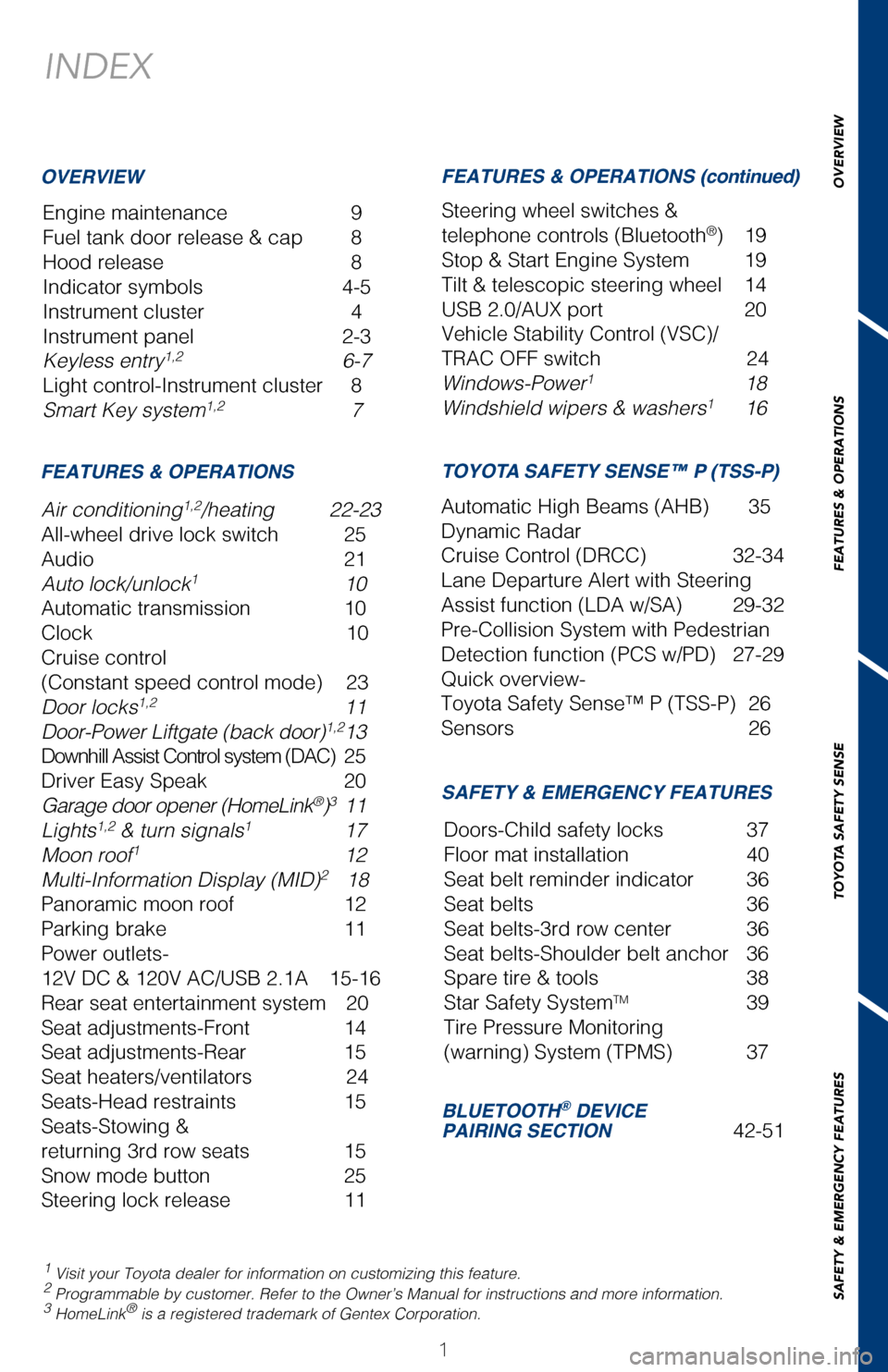
OVERVIEW
FEATURES & OPERATIONS
TOYOTA SAFETY SENSE
SAFETY & EMERGENCY FEATURES
1
INDEX
1 Visit your Toyota dealer for information on customizing this feature.2 Programmable by customer. Refer to the Owner’s Manual for instructio\
ns and more information.3 HomeLink® is a registered trademark of Gentex Corporation.
HIGHLANDER 2017
This Quick Reference Guide is a summary of basic vehicle
operations. It contains brief descriptions of fundamental
operations so you can locate and use the vehicle’s main
equipment quickly and easily.
The Quick Reference Guide is not intended as a substitute for
the Owner’s Manual located in your vehicle’s glove box. We
strongly encourage you to review the Owner’s Manual and
supplementary manuals so you will have a better understanding
of your vehicle’s capabilities and limitations.
Your dealership and the entire staff of Toyota Motor Sales,
U.S.A., Inc. wish you many years of satisfied driving in your new
Highlander.
A word about safe vehicle operations
This Quick Reference Guide is not a full description of Highlander operations.
Every Highlander owner should review the Owner’s Manual that accompanies
this vehicle.
Pay special attention to the boxed information highlighted in color throughout
the Owner’s Manual. Each box contains safe operating instructions to \
help you
avoid injury or equipment malfunction.
All information in this Quick Reference Guide is current at the time of \
printing.
Toyota reserves the right to make changes at any time without notice.
Engine maintenance 9
Fuel tank door release & cap 8
Hood release 8
Indicator symbols 4-5
Instrument cluster 4
Instrument panel 2-3
Keyless entry
1,2 6-7
Light control-Instrument cluster 8
Smart Key system
1,2 7
OVERVIEW
FEATURES & OPERATIONS FEATURES & OPERATIONS (continued)
SAFETY & EMERGENCY FEATURES TOYOTA SAFETY SENSE™ P (TSS-P)
Air conditioning1,2/heating 22-23
All-wheel drive lock switch 25
Audio 21
Auto lock/unlock
1 10
Automatic transmission 10
Clock 10
Cruise control
(Constant speed control mode) 23
Door locks
1,2 11
Door-Power Liftgate (back door)1,2 13
Downhill Assist Control system (DAC) 25
Driver Easy Speak 20
Garage door opener (HomeLink
®)3 11
Lights1,2 & turn signals1 17
Moon roof1 12
Multi-Information Display (MID)2 18
Panoramic moon roof 12
Parking brake 11
Power outlets-
12V DC & 120V AC/USB 2.1A 15-16
Rear seat entertainment system 20
Seat adjustments-Front 14
Seat adjustments-Rear 15
Seat heaters/ventilators 24
Seats-Head restraints 15
Seats-Stowing &
returning 3rd row seats 15
Snow mode button 25
Steering lock release 11Steering wheel switches &
telephone controls (Bluetooth
®) 19
Stop & Start Engine System 19
Tilt & telescopic steering wheel 14
USB 2.0/AUX port 20
Vehicle Stability Control (VSC)/
TRAC OFF switch 24
Windows-Power
1 18
Windshield wipers & washers1 16
Automatic High Beams (AHB) 35
Dynamic Radar
Cruise Control (DRCC) 32-34
Lane Departure Alert with Steering
Assist function (LDA w/SA) 29-32
Pre-Collision System with Pedestrian
Detection function (PCS w/PD) 27-29
Quick overview-
Toyota Safety Sense™ P (TSS-P) 26
Sensors 26
BLUETOOTH® DEVICE
PAIRING SECTION 42-51
Doors-Child safety locks 37
Floor mat installation
40
Seat belt reminder indicator 36
Seat belts 36
Seat belts-3rd row center 36
Seat belts-Shoulder belt anchor 36
Spare tire & tools 38
Star Safety System
TM 39
Tire Pressure Monitoring
(warning) System (TPMS) 37
2017_Highlander_QRG_V1_1.indd 111/22/16 11:40 PM
Page 4 of 56
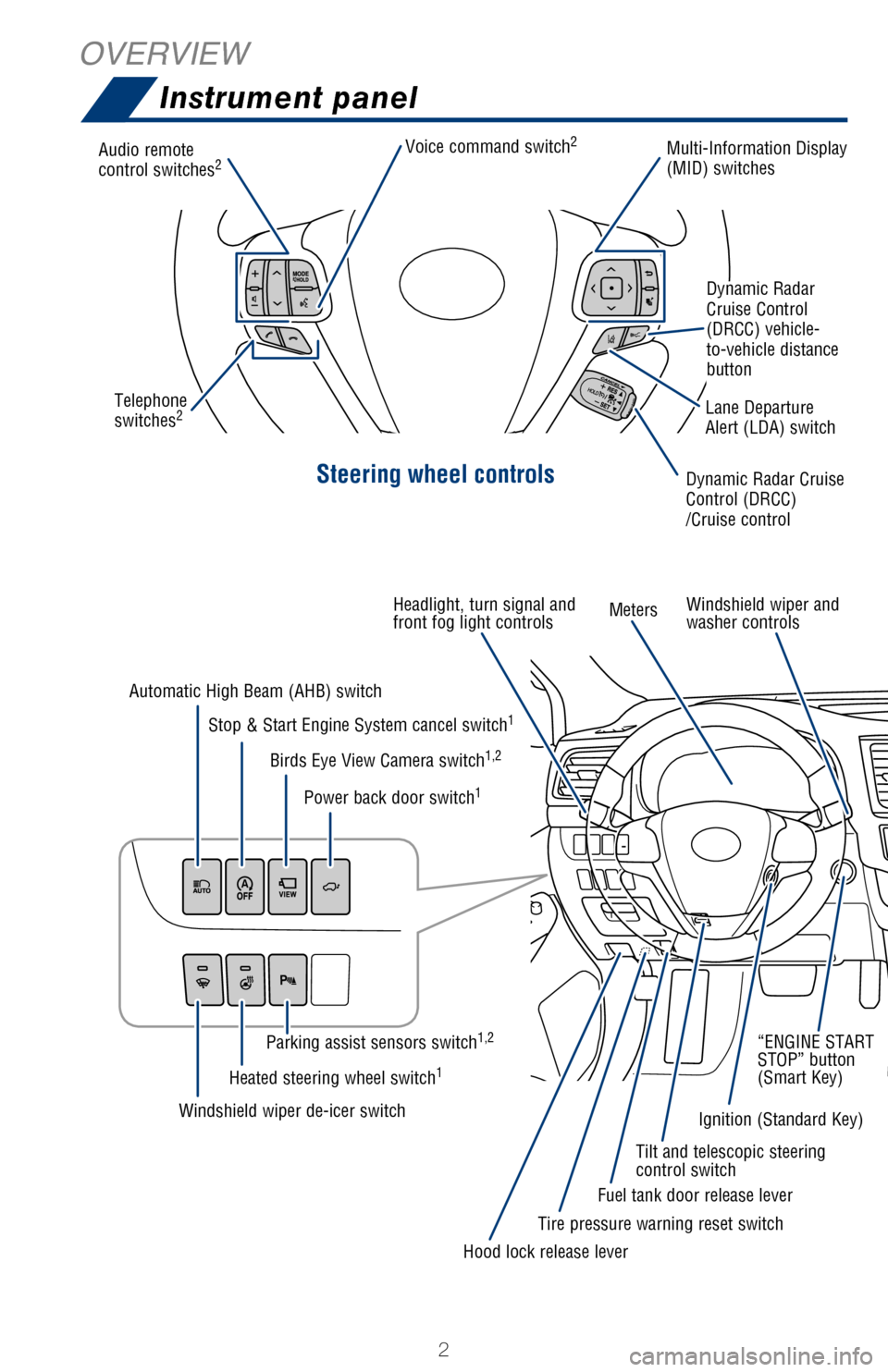
2
Steering wheel controls
Audio remote
control switches2Multi-Information Display
(MID) switchesDynamic Radar Cruise
Control
(DRCC)
/Cruise control
Dynamic Radar
Cruise Control
(DRCC) vehicle-
to-vehicle distance
button
Lane Departure
Alert (LDA) switch
Tilt and telescopic steering
control switch
Headlight, turn signal and
front fog light controls
Meters
Windshield wiper and
washer controls
Clock
“ENGINE START
STOP” button
(Smart Key)
Ignition (Standard Key)
Hood lock release lever Fuel tank door release lever
Tire pressure warning reset switch
Windshield wiper de-icer switch
Heated steering wheel switch
1
Parking assist sensors switch1,2
Automatic High Beam (AHB) switch
Stop & Start Engine System cancel switch
1
Birds Eye View Camera switch1,2
Power back door switch1
Voice command switch2
Telephone
switches2 1
If equipped2 For details, refer to the “Navigation System Owner’s Manual” and “2017 Entune™ Audio
Quick Reference Guide.”
OVERVIEW
Instrument panel
2017_Highlander_QRG_V1_1.indd 211/22/16 11:28 PM
Page 5 of 56
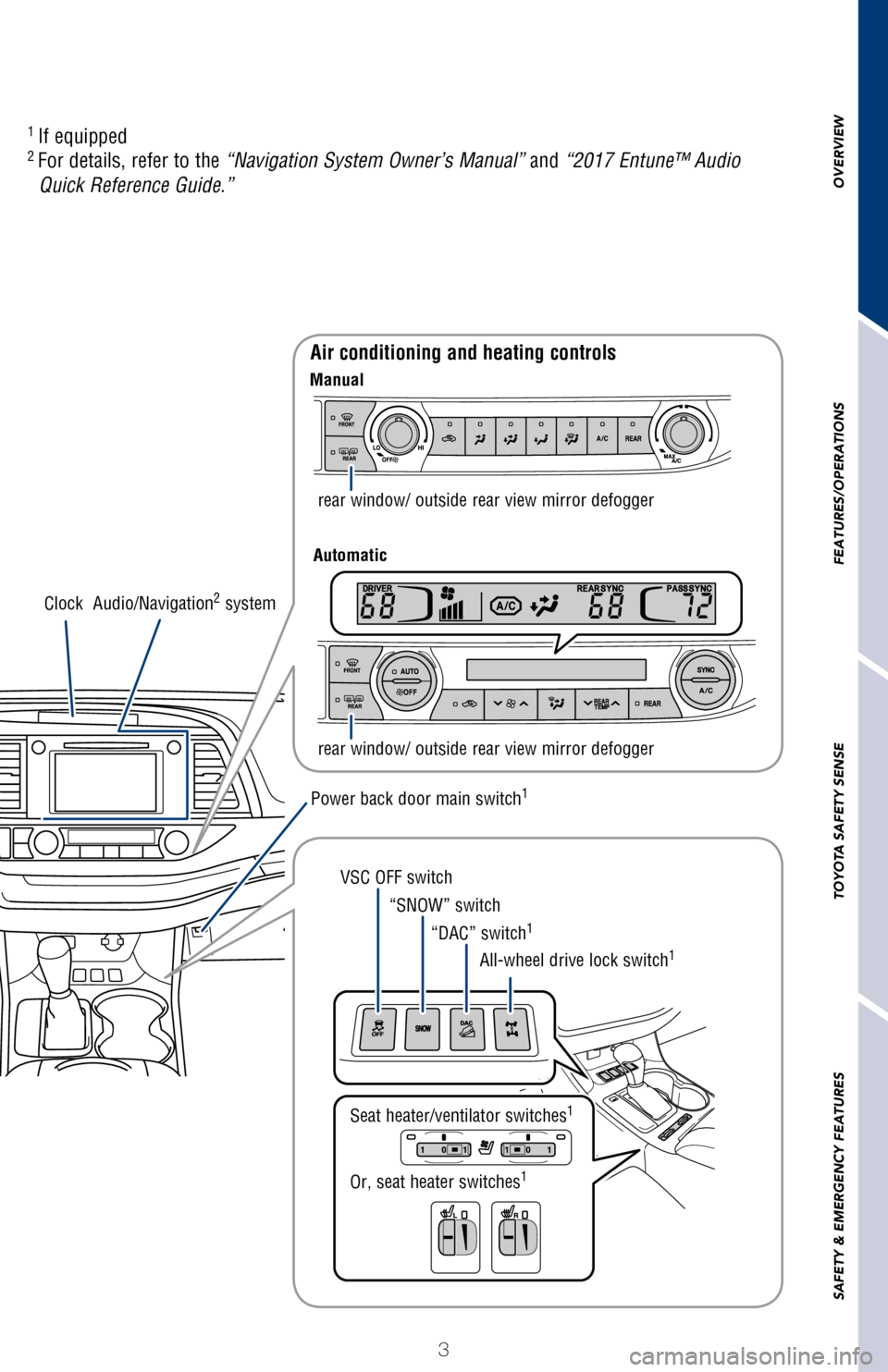
OVERVIEW
FEATURES/OPERATIONS
TOYOTA SAFETY SENSE
SAFETY & EMERGENCY FEATURES
3
Multi-Information Display
(MID) switches
Dynamic Radar Cruise
Control
(DRCC)
/Cruise control
Dynamic Radar
Cruise Control
(DRCC) vehicle-
to-vehicle distance
button
Lane Departure
Alert (LDA) switch
Tilt and telescopic steering
control switch Windshield wiper and
washer controls
Clock
“ENGINE START
STOP” button
(Smart Key)
Ignition (Standard Key)
Audio/Navigation2 system rear window/ outside rear view mirror defogger
rear window/ outside rear view mirror defogger
Air conditioning and heating controls
Power back door main switch1
VSC OFF switch
“SNOW” switch
“DAC” switch
1
All-wheel drive lock switch1
Seat heater/ventilator switches1
Or, seat heater switches1
1
If equipped2 For details, refer to the “Navigation System Owner’s Manual” and “2017 Entune™ Audio
Quick Reference Guide.”
Manual
Automatic
2017_Highlander_QRG_V1_1.indd 311/22/16 11:28 PM
Page 12 of 56
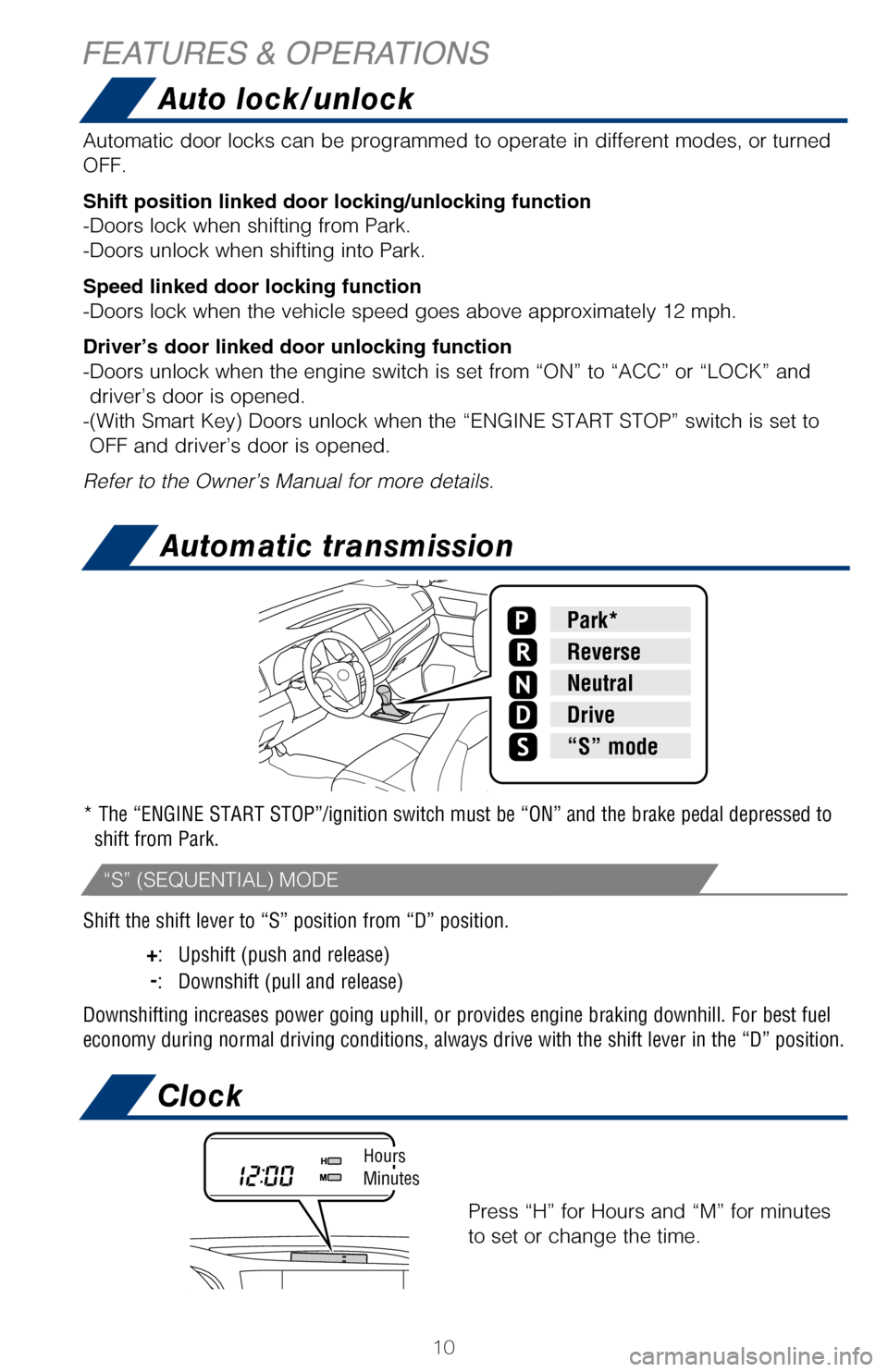
10
Shift the shift lever to “S” position from “D” position.
+: Upshift (push and release)
-: Downshift (pull and release)
Downshifting increases power going uphill, or provides engine braking do\
wnhill. For best fuel
economy during normal driving conditions, always drive with the shift le\
ver in the “D” position.
Park*
Reverse
Neutral
Drive
N
“S” mode
With Smart Key system
* The “ENGINE START STOP”/ignition switch must be “ON” and t\
he brake pedal depressed to shift from Park.
Automatic door locks can be programmed to operate in different modes, or\
turned
OFF.
Shift position linked door locking/unlocking function
-Doors lock when shifting from Park.
-Doors unlock when shifting into Park.
Speed linked door locking function
-Doors lock when the vehicle speed goes above approximately 12 mph.
Driver’s door linked door unlocking function
-Doors unlock when the engine switch is set from “ON” to “ACC”\
or “LOCK” and
driver’s door is opened.
-(With Smart Key) Doors unlock when the “ENGINE START STOP” swit\
ch is set to OFF and driver’s door is opened.
Refer to the Owner’s Manual for more details.
Garage door openers manufactured under license from HomeLink®* can be
programmed to operate garage doors, estate gates, security lighting, etc\
.
Refer to “Garage door opener,” Section 6-4 in the Owner’s Manua\
l for more details.
For programming assistance, contact HomeLink
® at 1-800-355-3515, or visit
http://www.homelink.com.
* HomeLink ®
is a registered trademark of Gentex Corporation.
Clock
Press “H” for Hours and “M” for minutes
to set or change the time.
HoursMinutes
FEATURES & OPERATIONS
“S” (SEQUENTIAL) MODE
Auto lock/unlock
Automatic transmission
2017_Highlander_QRG_V1_1.indd 1011/22/16 11:28 PM
Page 40 of 56
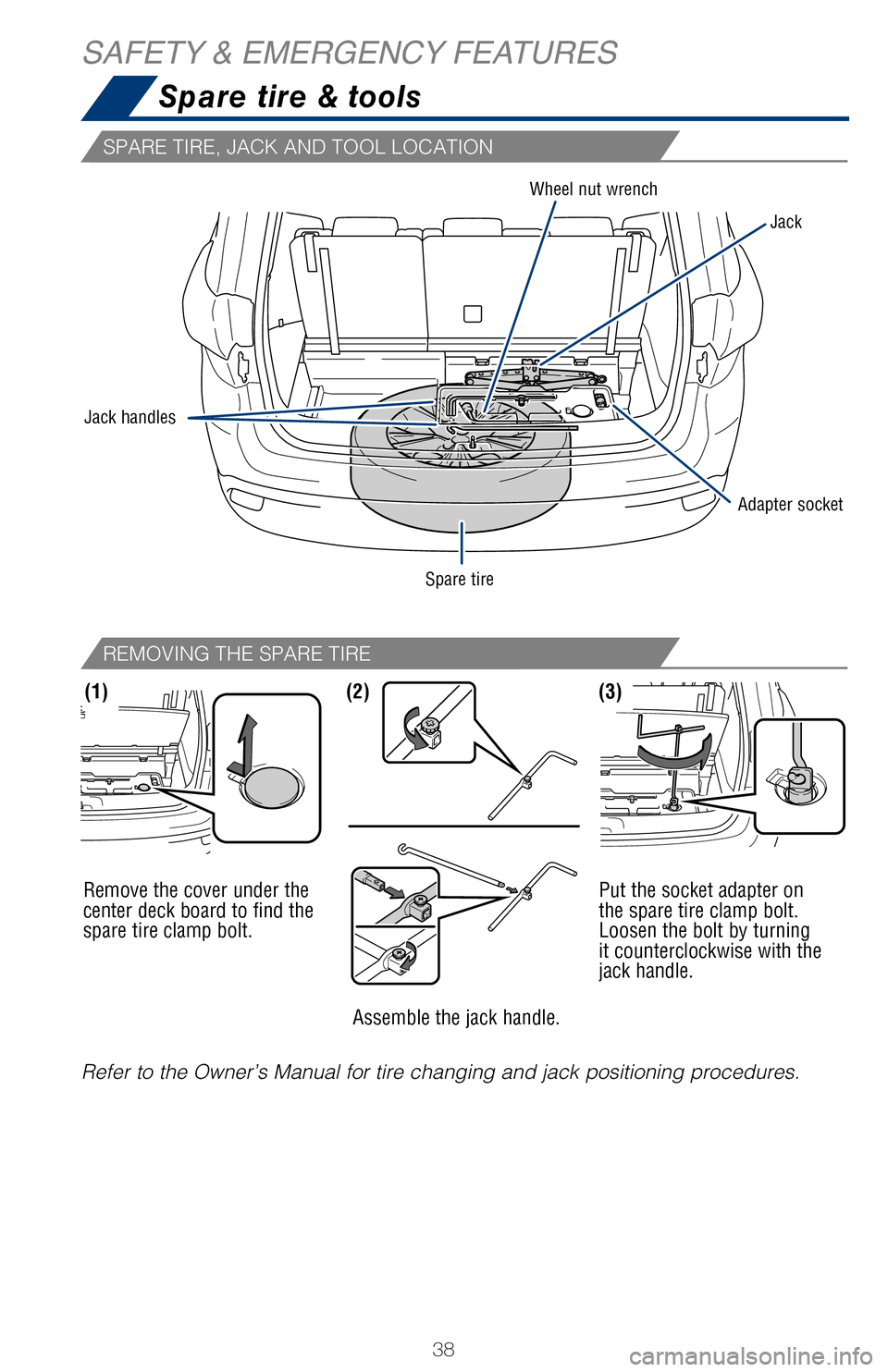
38
Refer to the Owner’s Manual for tire changing and jack positioning pr\
ocedures.Remove the cover under the
center deck board to find the
spare tire clamp bolt.
Assemble the jack handle.Put the socket adapter on
the spare tire clamp bolt.
Loosen the bolt by turning
it counterclockwise with the
jack handle.
(1)(3)(2)
SPARE TIRE, JACK AND TOOL LOCATION
REMOVING THE SPARE TIRE
Spare tire & tools
SAFETY & EMERGENCY FEATURES
Adapter socket
Jack handles Wheel nut wrench
Jack
Spare tire
Smart Stop Technology® automatically reduces engine power when the accelerator
and brake pedals are pressed simultaneously under certain conditions.
SST engages when the accelerator is depressed first and the brakes are a\
pplied
firmly for longer than one-half second at speeds greater than five miles\
per hour.
SST doesn’t engage if the brake pedal is depressed before the acceler\
ator pedal,
allowing vehicles to start on a steep hill and safely accelerate without\
rolling
backward. VSC helps prevent loss of traction during cornering by reducing engine p\
ower and
applying brake force to selected wheels.
Toyota’s VSC monitors steering angle and the direction your vehicle i\
s traveling.
When it senses that the front or rear wheels begin to lose traction, VSC\
reduces
engine power and applies braking to selected wheels. This helps restore \
traction
and vehicle control.
Toyota’s ABS sensors detect which wheels are locking up and limits wh\
eel lockup
by “pulsing” each wheel’s brakes independently. Pulsing release\
s brake pressure
repeatedly for fractions of a second. This helps the tires attain the tr\
action that
current road conditions will allow, helping you to stay in directional c\
ontrol.
Brake Assist is designed to detect sudden or “panic” braking, and \
then add braking
pressure to decrease the vehicle’s stopping distance. When there’s\
only a split
second to react, Brake Assist can add additional brake pressure more qui\
ckly than
just the driver alone can. Helps to maintain drive power and prevent the 4 wheels from spinning whe\
n starting
the vehicle or accelerating on slippery roads.
Toyota’s ABS technology has Electronic Brake-force Distribution (EBD\
) to help
maintain stability and balance when braking. Abrupt stops cause the vehi\
cle to tilt
forward, reducing the braking power of the rear wheels. EBD responds to \
sudden
stops by redistributing brake force to maximize the braking effectivenes\
s of all four
wheels. All new Toyota vehicles come standard with the Star Safety System
TM, which
combines Vehicle Stability Control (VSC), Traction Control (TRAC), A\
nti-lock Brake
System (ABS), Electronic Brake-force Distribution (EBD), Brake Assis\
t (BA) and
Smart Stop Technology (SST).
Refer to the Owner’s Manual for more details and important information on limitations
to these systems.
VEHICLE STABILITY CONTROL (VSC)
ACTIVE TRACTION CONTROL (A-TRAC)
MULTI-TERRAIN ANTI-LOCK BRAKE SYSTEM (ABS)
ELECTRONIC BRAKE FORCE DISTRIBUTION (EBD)
BRAKE ASSIST (BA)
SMART STOP TECHNOLOGY® (SST)
2017_Highlander_QRG_V1_1.indd 3811/22/16 11:29 PM
Page 41 of 56
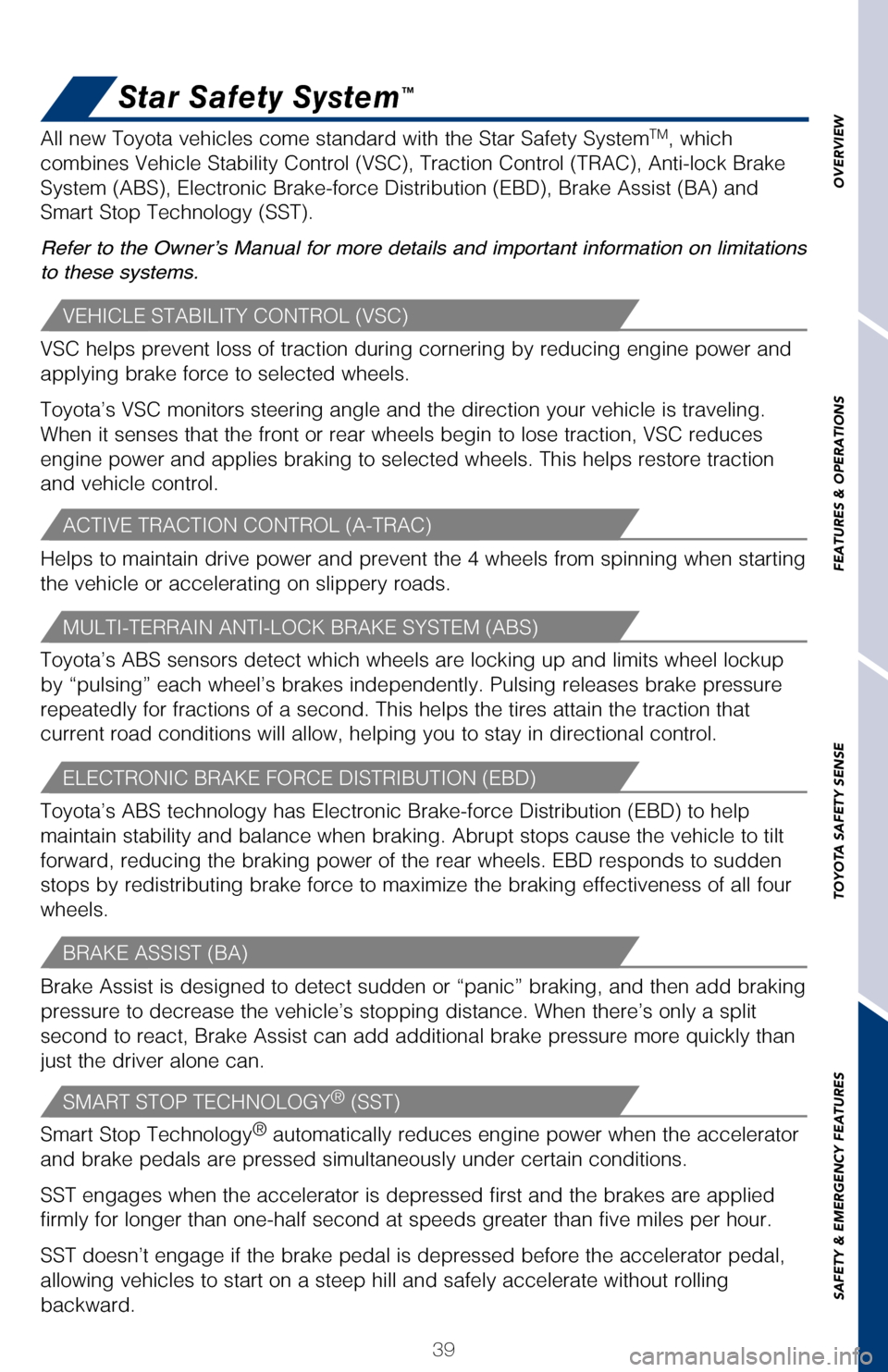
39
OVERVIEW
FEATURES & OPERATIONS
TOYOTA SAFETY SENSE
SAFETY & EMERGENCY FEATURES
Refer to the Owner’s Manual for tire changing and jack positioning pr\
ocedures. Put the socket adapter on
the spare tire clamp bolt.
Loosen the bolt by turning
it counterclockwise with the
jack handle.
Spare tire & tools
Adapter socketJack
Star Safety System™
Smart Stop Technology® automatically reduces engine power when the accelerator
and brake pedals are pressed simultaneously under certain conditions.
SST engages when the accelerator is depressed first and the brakes are a\
pplied
firmly for longer than one-half second at speeds greater than five miles\
per hour.
SST doesn’t engage if the brake pedal is depressed before the acceler\
ator pedal,
allowing vehicles to start on a steep hill and safely accelerate without\
rolling
backward. VSC helps prevent loss of traction during cornering by reducing engine p\
ower and
applying brake force to selected wheels.
Toyota’s VSC monitors steering angle and the direction your vehicle i\
s traveling.
When it senses that the front or rear wheels begin to lose traction, VSC\
reduces
engine power and applies braking to selected wheels. This helps restore \
traction
and vehicle control.
Toyota’s ABS sensors detect which wheels are locking up and limits wh\
eel lockup
by “pulsing” each wheel’s brakes independently. Pulsing release\
s brake pressure
repeatedly for fractions of a second. This helps the tires attain the tr\
action that
current road conditions will allow, helping you to stay in directional c\
ontrol.
Brake Assist is designed to detect sudden or “panic” braking, and \
then add braking
pressure to decrease the vehicle’s stopping distance. When there’s\
only a split
second to react, Brake Assist can add additional brake pressure more qui\
ckly than
just the driver alone can. Helps to maintain drive power and prevent the 4 wheels from spinning whe\
n starting
the vehicle or accelerating on slippery roads.
Toyota’s ABS technology has Electronic Brake-force Distribution (EBD\
) to help
maintain stability and balance when braking. Abrupt stops cause the vehi\
cle to tilt
forward, reducing the braking power of the rear wheels. EBD responds to \
sudden
stops by redistributing brake force to maximize the braking effectivenes\
s of all four
wheels. All new Toyota vehicles come standard with the Star Safety System
TM, which
combines Vehicle Stability Control (VSC), Traction Control (TRAC), A\
nti-lock Brake
System (ABS), Electronic Brake-force Distribution (EBD), Brake Assis\
t (BA) and
Smart Stop Technology (SST).
Refer to the Owner’s Manual for more details and important information on limitations
to these systems.
VEHICLE STABILITY CONTROL (VSC)
ACTIVE TRACTION CONTROL (A-TRAC)
MULTI-TERRAIN ANTI-LOCK BRAKE SYSTEM (ABS)
ELECTRONIC BRAKE FORCE DISTRIBUTION (EBD)
BRAKE ASSIST (BA)
SMART STOP TECHNOLOGY® (SST)
2017_Highlander_QRG_V1_1.indd 3911/22/16 11:29 PM